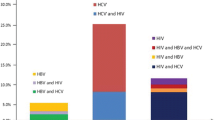Abstract
Injection drug use and associated hepatitis C virus (HCV) and HIV infections are on the rise in Russia and the republics of the former Soviet Union. While small targeted studies have found widespread drug use and disease among at-risk populations, there have been few attempts to comprehensively evaluate the extent of these epidemics in general post-Soviet societies. We conducted a two-stage cluster randomized survey of the entire adult population of T'bilisi, Republic of Georgia and assessed the burden of HCV, HIV, and risk behaviors for blood-borne infections in 2,000 study participants. Of the 2,000 surveyed individuals, 162 (8.1%) had injected illicit drugs during their lifetimes. Of the individuals who had injected illicit drugs, 138 (85.2%) reported sharing needles with injection partners. HCV was found in 134 (6.7%) of the total surveyed population, but in 114 (70.4%) of those who had injected illicit drugs. We found HIV in only three (0.2%) individuals, all of whom had injected illicit drugs. Injection drug use and high-risk injection practices are very common in Georgia and may be harbingers of a large burden of HCV-associated liver diseases and a potentially serious HIV epidemic in the years to come.


Similar content being viewed by others

Abbreviations
- HCV:
-
hepatitis C virus
- IDU:
-
injection drug users
- STI:
-
sexually transmitted infection
References
Global burden of disease (GBD) for hepatitis C. J Clin Pharmacol. 2004;44:20–29.
Abdala N, Carney JM, Durante AJ, et al. Estimating the prevalence of syringe-borne and sexually transmitted diseases among injection drug users in St Petersburg, Russia. Int J STD AIDS. 2003;14:697–703.
Reshetnikov OV, Khryanin AA, Teinina TR, Krivenchuk NA, Zimina IY. Hepatitis B and C seroprevalence in Novosibirsk, western Siberia. Sex Transm Infect. 2001;77:463.
Mikhailov MI, Gomberg MA, Dolzhanskaya NA, Koubanova AA. Significance of sexual route of transmission of hepatitis B and C in Russia. Int J STD AIDS. 2002;13(Suppl 2):9–11.
Ambrozaitis A, KS ZA, Balc IG, Widell A. Hepatitis C in Lithuania: incidence, prevalence, risk factors and viral genotypes. Clin Diagn Virol. 1995;4:273–284.
Lvov DK, Samokhvalov EI, Tsuda F, et al. Prevalence of hepatitis C virus and distribution of its genotypes in Northern Eurasia. Arch Virol. 1996;141:1613–1622.
Drobeniuc J, Hutin YJ, Harpaz R, et al. Prevalence of hepatitis B, D and C virus infections among children and pregnant women in Moldova: additional evidence supporting the need for routine hepatitis B vaccination of infants. Epidemiol Infect. 1999;123:463–467.
Butsashvili M, Tsertsvadze T, McNutt LA, Kamkamidze G, Gvetadze R, Badridze N. Prevalence of hepatitis B, hepatitis C, syphilis and HIV in Georgian blood donors. Eur J Epidemiol. 2001;17:693–695.
Zaller N, Nelson KE, Aladashvili M, Badridze N, del Rio C, Tsertsvadze T. Risk factors for hepatitis C virus infection among blood donors in Georgia. Eur J Epidemiol. 2004;19:547–553.
Tkeshelashvilli-Kessler A, del Rio C, Nelson K, Tsertsvadze T. The emerging HIV/AIDS epidemic in Georgia. Int J STD AIDS. 2005;16:61–67.
Koshkina EA. The prevalence of the use of narcotics and other psychoactive substances in Russia today. Zh Mikrobiol Epidemiol Immunobiol. 2000;15–19.
Lowndes CM, Alary M, Platt L. Injection drug use, commercial sex work, and the HIV/STI epidemic in the Russian Federation. Sex Transm Dis. 2003;30:46–48.
Kelly JA, Amirkhanian YA. The newest epidemic: a review of HIV/AIDS in Central and Eastern Europe. Int J STD AIDS. 2003;14:361–371.
Skarbinski J, Walker HK, Baker LC, Kobaladze A, Kirtava Z, Raffin TA. The burden of out-of-pocket payments for health care in Tbilisi, Republic of Georgia. JAMA. 2002;287:1043–1049.
Domen RE. Paid-versus-volunteer blood donation in the United States: a historical review. Transfus Med Rev. 1995;9:53–59.
Strauss RG. Blood donations, safety, and incentives. Transfusion. 2001;41:165–167.
van der Poel CL, Seifried E, Schaasberg WP. Paying for blood donations: still a risk? Vox Sang. 2002;83:285–293.
Aris B. Russia confronts the threat of AIDS. The Lancet. 2004;364:2007–2008.
Arita I, Nakane M, Kojima K, Yoshihara N, Nakano T, El Gohary A. Role of a sentinel surveillance system in the context of global surveillance of infectious diseases. Lancet Infect Dis. 2004;4:171–177.
Rehle T, Lazzari S, Dallabetta G, Asamoah-Odei E. Second-generation HIV surveillance: better data for decision-making. Bull World Health Organ. 2004;82:121–127.
UNAIDS. Global HIV/AIDS and STD Surveillance: Epidemiological Factsheets. 11-23-2004.
Ryabochkin A. Azerbaijan remains the key territory for transit of drugs from Afganistan, the interior minister states. Turan news agency (Baku). November 25, 2004.
Acknowledgements
We thank colleagues at the Georgian AIDS and Clinical Immunology Research Center for their hard work and dedication. This work is supported in part by the Biotechnology Engagement Program (BTEP) (G-616P to K.N.).
Author information
Authors and Affiliations
Corresponding author
Additional information
Stvilia, Tsertsvadze, Sharvadze, and Aladashvili are with the Georgian AIDS and Clinical Immunology Research Center, T'bilisi, Republic of Georgia; Rio is with the Department of Medicine, Emory University School of Medicine, Atlanta, GA, USA; Kuniholm and Nelson are with the Department of Epidemiology, Johns Hopkins Bloomberg School of Public Health, 615 N. Wolfe St., Baltimore, MD 21205, USA; Nelson is with the Department of Medicine, Johns Hopkins Medical Institutions, Baltimore, MD, USA.
Rights and permissions
About this article
Cite this article
Stvilia, K., Tsertsvadze, T., Sharvadze, L. et al. Prevalence of Hepatitis C, HIV, and Risk Behaviors for Blood-Borne Infections: A Population-Based Survey of the Adult Population of T'bilisi, Republic of Georgia. JURH 83, 289–298 (2006). https://doi.org/10.1007/s11524-006-9032-y
Published:
Issue Date:
DOI: https://doi.org/10.1007/s11524-006-9032-y



